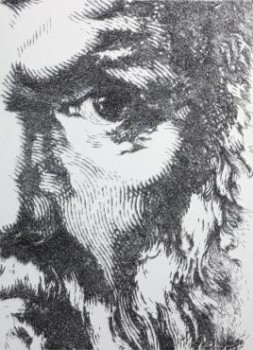Baptiste Debombourg, Innocent slaughter

© Patricia Dorfmann
The history of engraving demonstrates that an image works through its capacity for expansion, adaptation and assimilation. In his search for an effective language, Baptiste Debombourg is obviously aiming to achieve striking force. The immediate legibility of his figures and the spectacular plasticity of his sculptures make an impact on those who look at them. Aby Warburg, a theorist of the “survival of images”, observes that the “pathos image” ranks as one of the immortal images1: in particular an image in which “effort and suffering are united at the same moment”. 2 Goethe’s description of the Laocoon can also be applied to the couple taken from a Rape of the Sabine Women by Jan Muller which Baptiste Debombourg has reproduced on a large scale for the Prix Meurice. It still has to do with war (between the sexes), as well as a twisting of the bodies expressing the twisting of the souls.
Several works by Baptiste Debombourg tackle the theme of competition and exceeding one’s own capacities.3 By copying masterpieces from the past the engraver exhibited his skill and vied with the masters. Thus in the 18th century the master of a drawing studio would advise his pupils to avoid “affectation, carelessness and mannerism” when copying, helping them to avoid the pitfall of an overstated interpretation, and reminding them of the need to keep at a respectful distance from the model. Baptiste Debombourg’s aggravures do not conform to this hierarchy of values. They convey both the process of slaughter and fetishization of the model. Their surface with its swirling shapes catches the light and sparkles. Insofar as the exercise involves not just copying, but reappropriating a model, the idea of competition emerges, not devoid of a masked aggressiveness. No doubt it is in this way that the irony contained in the title of a series of drawings called “Tradition Of Excellence” should be understood. Their architectonic structure, close to Vauban’s military fortresses, conjures up the contours of antipersonnel mines, invisible threats of death.
The distancing made possible by the mechanical aggravure process seems to echo the Césium mask, the fractal shape of which explodes the reflection of anyone standing opposite it. According to Nietzsche, “the ‘ego’ is just a word, a pure surface result of a deep hierarchical conflict”4 . Therefore it can do no more than borrow a variety of masks to express itself freely. Baptiste Debombourg draws on the history of engraving as on a repertory of forms, in a post-modern quotational approach involving the free construction of a polyphonic language: The likeness orchestrates a strategy of glides and masks. This is the case where the portrait by Cornelis Van Haarlem engraved by Jan Muller is concerned, which the artist transforms into a possible representation of God. The serious eye which is the central focus of the composition seems to be judging the slaughter it is witnessing.
Taking over from the eye, the aggravure of a hand sketches a gesture of denunciation. But its gesticulation evokes above all the hand of God depicted by Michelangelo in The Creation of Adam in the Sistine Chapel. “God created man in his own image, in the image of God created he him,” we read in the Book of Genesis. A whole theology of the image ensues from it, turning resemblance and conformity to the model into a symbol of subordination to good. In Debombourg, the technique oscillates between “made-to-measure” restoration and havoc associated with excess: what the Greeks called “hubris”. The paradox of a destructive gesture (defacing an object or an image) allied with a gesture of reparation characterizes his sculptural practice. That contradiction, visible in the final form of the works, presents them as resulting from a succession of obstacles and problems to be overcome. Therefore it is always a question of struggle and attempted victory. That being said, the patient, considered craftsman’s hand is also present in this collection of works. The reference to the painstaking practice of engravers is constant, and the tool used to make the aggravures is an upholstery staple gun. For its part, the plastic bag covered with gold leaf (pointedly entitled Marx), made with David Marin, deploys incredibly delicate and laborious craftsmanship. And when Baptiste Debombourg chooses to tell us how many hours his pieces take to make, it is in order to upgrade the value of his working time. Everything is a question of point of view: The hand that slaughters is also the hand that builds.
1 Aby Warburg went so far as to attempt to draw up a “typology of pathos formulas”: “abduction”, “rape”, “combat”, “lamentation” and “crucifixion” are among the “pathos images”.
2 J.W. Goethe as quoted by Georges Didi-Huberman, L’Image survivante, p. 208, Éditions de Minuit
3 Arc de Triomphe, 2001, Sculpture Vivante, 2002, Rangers, 2011 may be quoted – http://www.isaberg-rapid.com/
4 Sarah Kofmann, Explosion II, p. 211, Éditions Galilée, 1993
Texte écrit pour la galerie Patricia Dorfmann.


